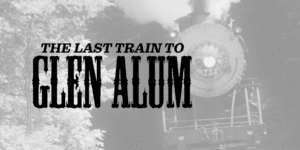One hundred and ten years ago, there was a murder, payroll robbery and posse chase through the hills of Mingo County. West Virginia Public Broadcasting reached back to the golden age of radio to create a radio play of the event called “The Last Train to Glen Alum.” Eric Douglas wrote the play.
‘The Last Train To Glen Alum’ Radio Drama
Douglas: Let’s talk about the atmosphere in West Virginia in 1914.
Stan Bumgardner: 1914 is in some ways, a pivotal year in West Virginia. There’s no way to quantify this, but certainly one of the deadliest coal mine strikes, or strikes period, in U.S. history was at Paint Creek and Cabin Creek in Kanawha County. At the time of the Glen Alum robbery, prohibition had just come into effect in West Virginia, which happened nearly six years before it happened nationally.
But what was happening in southern West Virginia was just massive change. And I mean, everything was changing. Before the Civil War, and even after the Civil War, you know, this had been a sparsely populated area, just some scattered farmland, and really not much of that because of the terrain. If you look at the census numbers, very few people lived in Mingo County, and in certain parts of McDowell County, very few people lived there until the railroads came. The railroad started coming in the 1880s and then by the 1890s, the Norfolk and Western had reached what’s now Mingo County. At that time it was part of Logan County. Mingo County is our newest county. It came in in 1895 and it’s almost solely due to the arrival of the N&W, the Norfolk and Western, and the opening of coal mines. Towns were being built, seemingly overnight, they were all over the place in that part of the state, and places where almost nobody had lived.





